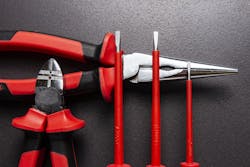It’s obvious that electricians are exposed to potentially lethal electricity on the job. What may not be so obvious is the dangers are not just to electricians and are not just in energized cabinets. More often than not, workplace electrocutions occur due to carelessness.
For example, a crane operator snags his boom on an overhead power line, energizing his crane to the 13,800 volts on that line. This fatality would have been prevented with a little planning. First, what path will that crane take to perform this job? Next, where in three-dimensional space will the boom be placed (or pass through) to perform this job?
Even if the overhead lines are at the mandated clearances, this particular job might mean the clearances are insufficient. Carpenters like to say, “Measure twice, cut once.” When it comes to overhead power lines, measure several times and change the job or de-energize those lines as needed.
Among electricians, a particular danger is the taped-up test lead. This is only arguably worse of a mistake than the DIY-insulated tool made with vinyl tape. Your life, when using those leads or those tools, depends upon insulation integrity.
Test leads aren’t free, but they cost a good bit less than, say, a new Corvette. You can afford to replace ones that are suspect.
Insulated tools are not just regular tools with a coating on them. They are specifically designed for the purpose, with special attention paid to the ergonomics of the tool. Aside from the obvious fact that you won’t get “tape slime” on your hand after using it (as is likely with a DIY version), it has a good, balanced and contoured feel to it (if it’s a major brand). You are less likely to drop it or get hand fatigue using it, and more likely to be precise in using it.
Water is another issue where electricity is concerned, yet it’s often dismissed in the need to get work done quickly. That rough-duty portable cord will protect the conductors from water, so what’s the big deal? The big deal is this is exactly how many people get electrocuted. It’s not usually the middle of the cord that’s the problem, although if the cord is abused (walked on, cut and taped up, kinked, etc.) it could be.
The problem is at the ends, where the uninsulated prongs mate with the energized socket or at the other end where you plug something into the cord. The prevention method is to keep the cord away from puddles and drips; if it does get wet, wipe it off before continuing.
A related item, the 120V power tool, is also a source of electrocution. Using double-insulated tools tends to eliminate the hazard. Always check the power cord to ensure its insulation is at 100% integrity; if that’s not the case, don’t use that tool.
Avoiding Additional Hazards
The preceding cautions can apply to any trade. With electricians, additional hazards lurk in energized panels. Some tips to prevent being fried while working on one:
- Use only insulated tools. And check the insulation before use.
- Don’t assume danger exists only at 480V or higher. The reason we have GFCI on 120V receptacles is you can be electrocuted by 120V. Many people who are careful around 480V treat 120V as totally nonthreatening — that can be a fatal error.
- Wear PPE suited for the highest voltage level present. At a minimum, wear insulating gloves.
- Use barriers. Let’s say you are working on the control circuits; the highest voltage there is 30V. But behind you there’s a 120V bus for the panel. You could place an insulating blanket over that section of the panel.
- Look for drop-zone issues. If there are nearby exposed conductors below the level at which you are working, use a barrier up (e.g., an insulating blanket) to prevent contact. Just because you drop something doesn’t mean it won’t bounce. If it lands on something energized, your impulse will be to pick it up.
- Close those openings! Protect yourself and others by ensuring all enclosure opens are closed to an extent that is similar to the wall of the enclosure in strength [110.12(A)].
The common thread through these tips is this: Wherever there is electricity, be careful to identify how you might come into contact with it. Then take the appropriate measures to prevent that from happening.
About the Author

Mark Lamendola
Mark is an expert in maintenance management, having racked up an impressive track record during his time working in the field. He also has extensive knowledge of, and practical expertise with, the National Electrical Code (NEC). Through his consulting business, he provides articles and training materials on electrical topics, specializing in making difficult subjects easy to understand and focusing on the practical aspects of electrical work.
Prior to starting his own business, Mark served as the Technical Editor on EC&M for six years, worked three years in nuclear maintenance, six years as a contract project engineer/project manager, three years as a systems engineer, and three years in plant maintenance management.
Mark earned an AAS degree from Rock Valley College, a BSEET from Columbia Pacific University, and an MBA from Lake Erie College. He’s also completed several related certifications over the years and even was formerly licensed as a Master Electrician. He is a Senior Member of the IEEE and past Chairman of the Kansas City Chapters of both the IEEE and the IEEE Computer Society. Mark also served as the program director for, a board member of, and webmaster of, the Midwest Chapter of the 7x24 Exchange. He has also held memberships with the following organizations: NETA, NFPA, International Association of Webmasters, and Institute of Certified Professional Managers.
